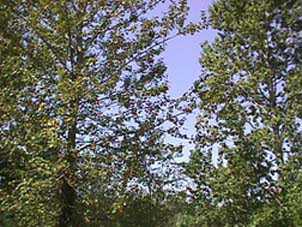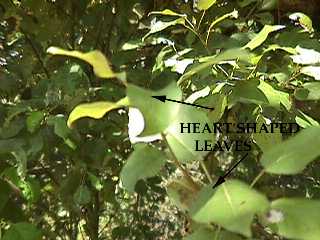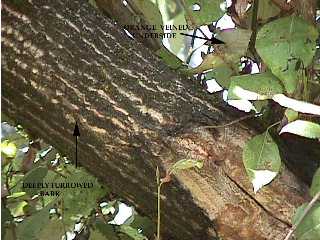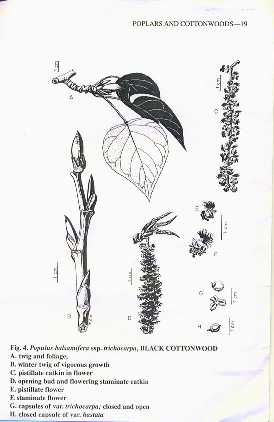



General Species Description
- Black cottonwood is usually the largest deciduous hardwood tree in our region, often reaching more than fifty meters tall and three meters in diameter. A native tree with bark light colored and rough texture. Winter buds are sticky and sweet-smelling.
Leaves
- Leaf shape is variable can be heart-shaped or triangular (usually broadest below the middle.) with a pointed tip and often lanceolate in juveniles. Typically measuring five to fifteen centimeters long and three to nine centimeters wide. Pronounced shiny dark green above and pale green to white below with prominant orange veins. A strong indicator of the variation of species is the lack of leaf fluttering in a slight breeze. Leaves turn yellow in the fall.
Inflorescence/Flowers
- Male catkins (staminate) in black cottonwoods are densely aligned along with many light purple stamens about two to three centimeters long. Male catkins are quick to fall off. Female (Pistillate) catkins (about eight to twenty centimeters long.) are distinctively cottony and remain on the stem for a longer period.
Fruits
- The three-valved capsules (one centimeter long) are arranged in long stringy clusters. Capsules are round, green, and hairy. The seeds are surrounded by fluffy white hairs (look like 'seedy' cotton balls when they disperse in the wind.) These fruits disperse prolifically from May to June.
Habitat
- Black cottonwoods are found in floodplains, forests, and along riverbanks throughout the Pacific Northwest. Some may further form stands on bottomlands, moist flats or any moist, usually sandy soils. In the occurence of both subspecies of Populus balsamifera sharing the same limited resource, there is a tendency for Populus balsamifera trichocarpa and its near intermediate to be associated with alluvial sites while the balsamifera ssp. to occur mainly on the uplands.
Range
- Black cottonwood can be found from Alaska to Baja and as far west as the Rocky mountains. Black cottonwoods are found in all counties in our area.
Similar Species
- Quaking aspen (Populus balsamifera tremuloides) is often confused with Black cottonwood. Differences are that the Aspen is a smaller tree (up to twenty-five meters) with smooth bark. Although both black cottonwood and quaking aspen have generally heart-shaped leaves, quaking aspen has much smaller, compact leaves (up to seven centemeters long) with flat leaf stalks, causing them to flutter in the slightest breeze. Black cottonwoods can be distinguished from the willows by its large heart-shaped leaves and by the way its fruits are attached along the long, draping catkins like a necklace of beads. The leaves of alders (Alnus ssp.) are also similar in shape to those of black cottonwoods, but alder leaves have more prominent veins that give them a pleated look unlike the smooth leaves of black cottonwoods.
Ecological Value
- Black cottonwoods are important in freshwater shoreline stabilization. Bees collect the bud resin which functions as an antiseptic. Black cottonwoods are also an important for nesting sights for the majestic giant blue heron.
Human Value
- The black cottonwoods' white, light and soft wood makes good crates, veneer and pulp. The bud resin has been used as an ingredient in antibiotic ointments for numerous ailments, as a glue, and for waterproofing. Native Americans ate the inner bark in the spring. The bark was stripped off trees to make buckets; roots were twisted into rope.
References
- Bradshaw, Christopher. 1996. Catkin-Bearing Plants of British Columbia. Canadian Cataloguing in Publication Data. 19 pp. Cooke, S. S. ed. 1997. A Field Guide to the Common Wetland Plants of Western Washington and Northwest Oregon. Seattle Audubon Society and Washington Native Plant Society. Seattle Audubon Society, Seattle WA, 7 pp. Guard, B. Jennifer. 1995. Wetland Plants of Oregon and Washington. Lone Star Publishing, Richmond, WA. 215 pp. Hitchcock, C. L. and Cronquist A. 1973. Flora of the Pacific Northwest. University of Washington Press, Seattle WA. 64 pp. Washington University Native Plant Society. 1994. Plant Life of Washington Territory. Washington University Cheney Publishing. Volume Five. 16 pp.
This page was created by: Laura Nash, August 1998
Return to Northwest Oregon Wetland Plants Project